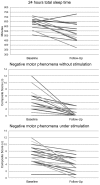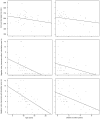Clinical and polysomnographic course of childhood narcolepsy with cataplexy
- PMID: 24142146
- PMCID: PMC3859221
- DOI: 10.1093/brain/awt277
Clinical and polysomnographic course of childhood narcolepsy with cataplexy
Abstract
Our aim was to investigate the natural evolution of cataplexy and polysomnographic features in untreated children with narcolepsy with cataplexy. To this end, clinical, polysomnographic, and cataplexy-video assessments were performed at diagnosis (mean age of 10 ± 3 and disease duration of 1 ± 1 years) and after a median follow-up of 3 years from symptom onset (mean age of 12 ± 4 years) in 21 children with narcolepsy with cataplexy and hypocretin 1 deficiency (tested in 19 subjects). Video assessment was also performed in two control groups matched for age and sex at first evaluation and follow-up and was blindly scored for presence of hypotonic (negative) and active movements. Patients' data at diagnosis and at follow-up were contrasted, compared with controls, and related with age and disease duration. At diagnosis children with narcolepsy with cataplexy showed an increase of sleep time during the 24 h; at follow-up sleep time and nocturnal sleep latency shortened, in the absence of other polysomnographic or clinical (including body mass index) changes. Hypotonic phenomena and selected facial movements decreased over time and, tested against disease duration and age, appeared as age-dependent. At onset, childhood narcolepsy with cataplexy is characterized by an abrupt increase of total sleep over the 24 h, generalized hypotonia and motor overactivity. With time, the picture of cataplexy evolves into classic presentation (i.e., brief muscle weakness episodes triggered by emotions), whereas total sleep time across the 24 h decreases, returning to more age-appropriate levels.
Keywords: cataplexy; children; narcolepsy; sleep; sleepiness.
Figures


Similar articles
-
Narcolepsy with cataplexy mimicry: the strange case of two sisters.J Clin Sleep Med. 2013 Jun 15;9(6):611-2. doi: 10.5664/jcsm.2764. J Clin Sleep Med. 2013. PMID: 23772196 Free PMC article.
-
Predictors of hypocretin (orexin) deficiency in narcolepsy without cataplexy.Sleep. 2012 Sep 1;35(9):1247-55F. doi: 10.5665/sleep.2080. Sleep. 2012. PMID: 22942503 Free PMC article.
-
The role of cerebrospinal fluid hypocretin measurement in the diagnosis of narcolepsy and other hypersomnias.Arch Neurol. 2002 Oct;59(10):1553-62. doi: 10.1001/archneur.59.10.1553. Arch Neurol. 2002. PMID: 12374492
-
Narcolepsies, update in 2023.Rev Neurol (Paris). 2023 Oct;179(7):727-740. doi: 10.1016/j.neurol.2023.08.001. Epub 2023 Aug 25. Rev Neurol (Paris). 2023. PMID: 37634997 Review.
-
[Narcolepsy: a new perspective on diagnosis and treatment].Ned Tijdschr Geneeskd. 2007 Apr 14;151(15):856-61. Ned Tijdschr Geneeskd. 2007. PMID: 17472116 Review. Dutch.
Cited by
-
Recognizing the Symptom Spectrum of Narcolepsy to Improve Timely Diagnosis: A Narrative Review.Nat Sci Sleep. 2021 Jul 7;13:1083-1096. doi: 10.2147/NSS.S278046. eCollection 2021. Nat Sci Sleep. 2021. PMID: 34262379 Free PMC article. Review.
-
Update on therapy for narcolepsy.Curr Treat Options Neurol. 2015 May;17(5):347. doi: 10.1007/s11940-015-0347-4. Curr Treat Options Neurol. 2015. PMID: 25854650
-
Assessing narcolepsy with cataplexy in children and adolescents: development of a cataplexy diary and the ESS-CHAD.Nat Sci Sleep. 2017 Aug 14;9:201-211. doi: 10.2147/NSS.S140143. eCollection 2017. Nat Sci Sleep. 2017. PMID: 28860883 Free PMC article.
-
Hypothalamus and amygdala functional connectivity at rest in narcolepsy type 1.Neuroimage Clin. 2021;31:102748. doi: 10.1016/j.nicl.2021.102748. Epub 2021 Jul 4. Neuroimage Clin. 2021. PMID: 34252875 Free PMC article.
-
Red Flags for early referral of people with symptoms suggestive of narcolepsy: a report from a national multidisciplinary panel.Neurol Sci. 2019 Mar;40(3):447-456. doi: 10.1007/s10072-018-3666-x. Epub 2018 Dec 12. Neurol Sci. 2019. PMID: 30539345 Free PMC article. Review.
References
-
- American Academy of Sleep Medicine. ICSD-2- International classification of sleep disorders: diagnostic and coding manual. 2nd edn. Westchester, IL: American Academy of Sleep Medicine; 2005.
-
- Broughton R, Dunham W, Newman J, Lutley K, Duschesne P, Rivers M. Ambulatory 24 hour sleep-wake monitoring in narcolepsy-cataplexy compared to matched controls. Electroencephalogr Clin Neurophysiol. 1988;70:473–81. - PubMed
-
- Cacciari E, Milani S, Balsamo A, Spada E, Bona G, Cavallo L, et al. Italian cross-sectional growth charts for height, weight and BMI (2 to 20 yr) J Endocrinol Invest. 2006;29:581–93. - PubMed
MeSH terms
Substances
LinkOut - more resources
Full Text Sources
Other Literature Sources

